
국내 더덕 속 식물의 형태학적 특성과 유효성분 함량 비교 분석
This is an open access article distributed under the terms of the Creative Commons Attribution Non-Commercial License (http://creativecommons.org/licenses/by-nc/3.0/) which permits unrestricted non-commercial use, distribution, and reproduction in any medium, provided the original work is properly cited.
Abstract
Among the Codonopsis plants, C. lanceolata and C. pilosula are cultivated for edible and medicinal purposes. But basic agronomic data of C. ussuriensis are required for domestic cultivation. This study aimed to compare the agronomic characteristics of the three Codonopsis species for cultivation.
The three Codonopsis species were cultivated in the same field and their agronomic characteristics were compared. C. ussuriensis demonstrated similar morphological characteristics to C. pilosula, such as hairless stems and leaves, stem color, wingless seeds, and root weight. However, the shape and size of the leaf and the color of the corolla are intermediate between C. lanceolata and C. pilosula. However, all three species showed different root shapes and seed sizes and weights. In terms of phytochemical components, the main components of C. lanceolata and C. pilosula were tangshenoside I and lobetyolin, while C. ussuriensis was ussurienoside I. Moreover, all components demonstrated high content with increasing annual age.
This study demonstrated different agronomic characteristics of C. ussuriensis compared to C. lanceolata and C. pilosula, and the results are valuable as basic data for cultivating C. ussuriensis.
Keywords:
Codonopsis lanceolata, Codonopsis pilosula, Codonopsis ussuriensis, Effective Components, Morphological Characteristics서 언
더덕 속 (Codonopsis)은 초롱꽃과 (Campanulaceae)에 속하는 다년생 초본으로 우리나라를 포함한 동아시아와 인도에 분포한다. 우리나라의 더덕 속에는 더덕 (C. lanceolata), 만삼 (C. pilosula), 소경불알 (C. ussuriensis) 및 애기더덕 (C. minima) 등 4 종이 있으며, 애기더덕은 한국 고유종으로 한라산 해발 1,100 m – 1,300 m에서 자생한다 (Kim and Kim, 2010).
만삼은 고산식물로 강원도 이북의 심산 지역과 지리산 천왕봉에서 주로 자생하며 (Lee et al., 2013), 강원도 태백산, 오대산, 설악산, 점봉산, 태기산 등 해발 1,000 m가 넘는 곳에서 자생지가 확인된 바 있다 (Lee et al., 1997; Son et al., 2015; Sun et al., 2020). 이에 비해, 더덕과 소경불알은 우리나라 전역에 분포하며, 다양한 지역에서 자생지가 보고되었다 (Yoo and Lee, 1989; Lee et al., 1997; Kim et al., 2015; Na et al., 2017; Kim et al., 2018; Sung et al., 2019).
현재 국내에서 재배되고 있는 더덕 속 작물은 더덕과 만삼으로 (Kang et al., 2001), 2021년 더덕의 재배면적은 2,225 ㏊, 수확면적은 1,529 ㏊, 생산량은 11,610 톤으로 조사되었으며, 2021년 만삼의 재배면적은 13 ㏊, 수확면적은 9 ㏊, 생산량은 26 톤으로 보고되었다 (MAFRA, 2022). 또한, 더덕과 만삼은 약용으로도 이용되는데, 더덕의 생약명은 양유 (羊乳)라고 하며, 한방에서는 치열 (治熱), 거담 (祛痰), 폐열 (肺熱)제거 등에 사용되고 있다 (Lee et al., 2017). 만삼의 생약명은 당삼(黨蔘)이라고 하며, 한방에서는 보혈 (寶血), 강장 (强壯), 구갈 (口渴) 등의 치료에 사용되고 있다 (Park et al., 2005).
소경불알은 국립생물자원관의 국가생물종으로 등록된 국내 자생식물로, 만삼아재비, 알더덕, 까치더덕 등의 이명으로 알려져 있다. 민간에서는 더덕처럼 줄기, 잎, 뿌리를 식용으로 이용하며, 한국본초도감과 익생양술 등 약초민간요법에서 오소리당삼 (烏蘇里黨參), 작삼 (鵲蔘) 등의 생약명으로 이용한다고 기록되어 있다 (Ahn, 2003). 비장 및 위의 기능 개선, 호흡기와 이비인후과 질환 등에 효능이 있는 것으로 알려져 있으나 식품의약안전처의 생약 자원으로는 등록되어 있지 않아 한약재로의 활용이 제한되고 있다.
소경불알에 관한 연구는 분류학 및 성분 분석 분야에서 기초적인 연구와 소경불알과 더덕/만삼의 기원 식물을 구분하기 위한 유전체 기반 분자표지 연구 결과가 보고되었으나 (Lee and Kim, 1989; Yoo and Lee, 1989; Lee and Ko, 1992; Kim and Yoo, 2011; Kim et al., 2023), 소경불알의 추출물 및 단일성분에 대한 약리학적 효능에 관한 연구는 거의 이루어지지 않았다. 최근에 소경불알의 주요 화합물인 ussurienoside I (syringin-3’-hydroxy-3’-methyl glutarate)이 농도 의존적으로 박테리아 뉴라미니다아제 활성 억제 효과를 나타내는 것으로 확인되었으며, 소경불알의 추출물 또는 단일 화합물이 약리학적 효능이 있음을 제시하였다 (Koo et al., 2022).
더덕과 만삼은 작물학적 연구가 많이 보고되었으며, 더덕은 피복 재료 및 생육 장소에 따른 생육 변화 등이 보고된 바 있고 (Kim, 2003; Yoon et al., 2016), 만삼은 입모율 향상을 위한 종자의 priming과 GA3 처리 및 왕겨 피복처리 등의 연구가 보고된 바 있다 (Kang et al., 2001; Lee et al., 2013). 소경불알은 농가의 주요 재배작물이 아니기 때문에 작물학적 연구는 부족한 실정이다. 그러나 최근 일부 재배 농가에서 소경불알을 까치더덕으로 부르며, 야생 종자를 증식하여 소규모로 재배하고 있어 앞으로 작물학적 연구가 필요할 것으로 생각된다
따라서 본 연구는 향후 고소득 작물로 활용이 가능한 소경불알의 농업적 형질 특성과 유효 성분 함량을 더덕 및 만삼과 비교함으로써 작물학적 기초자료를 만들기 위해 수행하게 되었다.
재료 및 방법
1. 재배법
본 연구에서 사용한 더덕 (C. lanceolata), 만삼 (C. pilosula) 및 소경불알 (C. ussuriensis)은 국립원예특작과학원 인삼특작부 약용작물과에서 수집·증식한 자원을 이용하였으며, 연구재료의 일부는 정확한 동정을 위해 석엽표본으로 제작하여 한국약용자원 표본관 (Korea Medicinal Resources Herbarium, KMRH)에 확증 표본으로 보관하였다 (표본번호: 더덕, MPS 006561; 만삼, MPS006562; 소경불알, MPS006563).
더덕 속 식물 3 종의 재배는 국립원예특작과학원 인삼특작부 시험포장 (해발 160 m)에서 실시하였다. 흰색 폴리에틸렌필름으로 멀칭한 시험구 (1 m × 5 m)를 조성하였으며, 재식거리는 조간 거리 20 ㎝, 주간 거리 25 ㎝, 3 열로 하였으며, 시험구의 배치는 난괴법 3 반복으로 하였다. 3월 초에 트레이에 파종하여 육묘하였으며, 5월 초 건전 육묘를 시험 포장에 이식하였다. 지상부의 초기 및 중기 생육 조사는 파종 후 4주 및 16 주 후에 실시하였으며, 지하부 생육 조사는 파종 후 32 주 후에 실시하였다. 생육 조사는 농촌진흥청 농업과학기술 연구조사 분석 기준에 준하여 실시하였다 (RDA, 2012).
2. 지표성분 분석
더덕의 지표성분인 tangshenoside I와 lobetyolin의 표준품은 ChemFaces (Wuhan, China)에서 구입하여 사용하였으며, 검액은 20 ㎎의 분쇄된 분말을 1 ㎖의 50% methanol에 현탁하여 1 시간 초음파 추출한 후, syringe filter (0.45 ㎛)로 여과하여 사용하였다.
분석은 Agilent 1260 Series HPLC System (Agilent Technologies Inc., Santa Clara, CA, USA)을 이용하였고, column은 YMC-Pack ODS-AM (4.6 ㎜ × 250 ㎜, 5 ㎛, YMC Co., Ltd., Kyoto, Japan)을 이용하였다. 분석 조건은 Xia 등 (2017)의 방법을 이용하였다.
검량선 작성을 위해 tangshenoside I와 lobetyolin 표준품을 50% methanol에 녹여 200, 100, 50, 25, 12.5, 6.25 ㎍/㎖의 농도로 제조한 후 HPLC 분석을 수행했으며, 면적에 대한 농도로 검량선을 작성하였다. 그 결과 tangshenoside I의 검량선 방정식은 Area = 10.639x + 0.5148 (x = ㎍/㎖, r2 = 1), lobetyolin의 검량선 방정식은 Area = 8.598x + 1.1068 (x = ㎍/㎖, r2 = 0.999)였다.
3. 통계분석
실험 결과는 SAS Enterprise Guide 4.2 (Statistical analysis system, 2009, Cary, NC, USA)로 분석하였고, 3 회 반복한 결과값을 평균치 ± 표준편차 (means ± SD)로 나타내었다. 시료 간의 유의적인 차이는 Duncan’s Multiple Range Test (DMRT)로 유의수준 5%에서 검증하였다 (p < 0.05).
결과 및 고찰
1. 더덕 속 3 종의 지상부 특성
파종 후 4 주 육묘한 초기 생육상태의 줄기와 잎의 외관적 특성을 살펴보면, 소경불알의 줄기와 잎은 가는 털이 보여 만삼과 비슷한 형태를 보였다 (Fig. 1). 더덕 (C. lanceolata)의 경우 털이 없어 소경불알 (C. ussuriensis), 만삼 (C. pilosula)과 다른 형태를 나타내었는데 이러한 잎의 털 유무는 더덕 속의 다른 종들과 더덕을 구분하는 특징 중에 하나로 알려져 있으며 (Yoo and Lee, 1989), 본 연구에서도 기존 연구와 결과가 일치하였으며, 이는 더덕의 고유 형질에 기인한 것으로 생각된다.
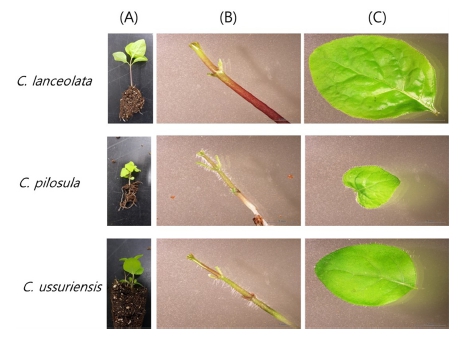
Morphological difference in stem and leaf among 3 Codonopsis species at the early growth stage.(A), (B) and (C) shows whole, stems and leaves of 4-week-old seedlings after sowing, respectively.
파종 후 16 주 된 중기 생육상태의 잎을 보면, 잎의 거치는 3 종 모두 거의 없는 상태이며, 잎의 크기는 더덕, 소경불알, 만삼의 순으로 나타났다 (Fig. 2).
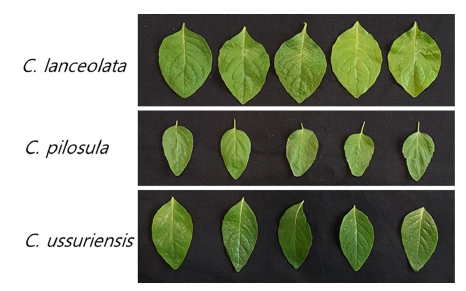
Morphological difference in leaf among 3 Codonopsis species at the mid-growth stage.The shape of leaves were observed in 16-week-old plants.
실제 생육 조사 결과를 보면, 엽장은 더덕 6.02 ± 0.40 ㎝, 소경불알 5.31 ± 0.38 ㎝, 만삼 3.91 ± 0.33 ㎝, 엽폭은 더덕 4.08 ± 0.25 ㎝, 소경불알 2.83 ± 0.13 ㎝, 만삼 2.50 ± 0.21 ㎝ 순으로 나타났으며, 장폭비 (엽장/엽폭)는 소경불알 1.81 ± 0.12, 만삼 1.57 ± 0.14, 더덕 1.48 ± 0.14 순으로 나타났다 (Table 1). 또한 만삼과 소경불알의 줄기색은 녹색 또는 녹자색인데 비해 더덕은 녹색, 녹자색뿐 아니라 짙은 자색이 존재하는 것으로 나타났다 (자료 미제시).
Yoo와 Lee (1989)의 연구에서 더덕, 만삼, 소경불알의 엽장은 각각 6.17 ㎝, 4.84 ㎝, 4.30 ㎝로 보고되어, 본 연구 결과와는 차이를 나타내었다. 이는 본 연구가 같은 장소에서 같은 기간 동안 재배한 것에 비해, 기존 연구의 경우 자생지에서 채취한 시료를 사용하였기 때문에 생육 연생의 차이, 서식지 환경에 의한 차이 등이 작용하였기 때문으로 생각된다.
2. 더덕 속 3 종의 화기 특성
개화 시기는 만삼의 경우 5월 초 시험 포장 정식 후 74 일, 소경불알은 81 일, 더덕은 93 일의 순으로 나타났으며, 개화기는 만삼은 83 일, 소경불알은 87 일, 더덕은 99 일의 순으로 나타났다 (자료 미제시).
꽃 모양은 3 종 모두 종형 (campanulate)이었으며, 화관은 끝이 5 갈래로 나누어져 뒤로 약간 말리는 형태를 보인다. 3종 모두 꽃받침과 수술은 5 개이고, 암술은 3 갈래로 나누어지며, 자방 형태는 오각형이었다. 화관의 경우 3 종 모두 5개였고, 바깥쪽의 색은 녹색을 띠었으나, 안쪽은 종마다 다른 특징을 보였다 (Fig. 3).
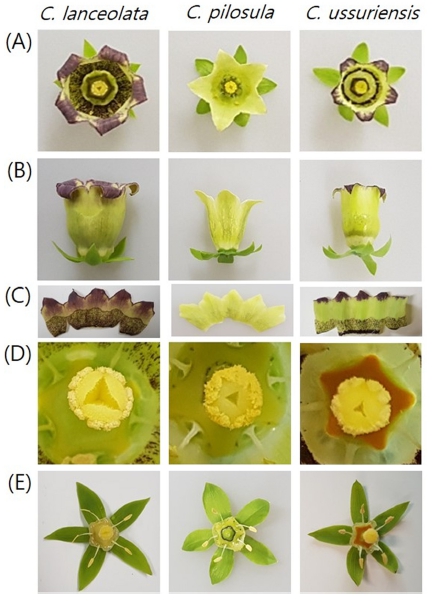
Morphological difference in flower among 3 Codonopsis species.The shape of flower and floral organs was observed during flowering period. (A); upper side of flower, (B); side of flower, (C); corolla, (D); pistil, (E); calyx and stamen, (F); ovary.
더덕의 경우 화관 안쪽의 윗부분은 자색을 띠고, 아래쪽 부분은 갈자색 반점이 보인다. 만삼의 경우 화관 안쪽 윗부분은 연녹색, 아래쪽 부분은 윗부분보다 진한 녹색이 불규칙한 모양으로 분포하며 반점은 나타나지 않았다. 소경불알의 경우 안 쪽 윗부분의 끝에만 자색이고, 중간은 연녹색, 아래쪽은 갈자색 반점이 보여 만삼과 더덕의 중간형질을 띠는 것으로 나타났다.
화관의 길이는 더덕이 3.46 ± 0.19 ㎝로 가장 컸으며, 만삼과 소경불알은 각각 2.49 ± 0.09 ㎝, 2.51 ± 0.14 ㎝로 나타났으나, 통계적으로 유의미한 차이는 없었다 (Table 2). 또한, 화관의 폭도 더덕이 1.95 ± 0.07 ㎝으로 가장 컸으며, 만삼과 소경불알은 각각 1.22 ± 0.03 ㎝, 1.26 ± 0.06 ㎝로 나타났으나, 통계적으로 유의미한 차이는 없었다. 화관의 장폭비는 반대로 더덕이 1.78 ± 0.10인데 비해 만삼과 소경불알은 각각 2.04 ± 0.10, 2.00 ± 0.13으로 나타났으며, 만삼과 소경불알 사이에 통계상 유의미한 차이는 없었다.
기존의 초롱꽃과의 외부 형태를 비교한 연구에서도 더덕, 소경불알, 애기더덕의 화관 안쪽에서 갈자색 반점이 나타난다고 보고된 바 있으며 (Yoo and Lee, 1996), 본 연구에서도 더덕과 소경불알 화관 안쪽에 갈자색 반점이 발견되어 기존 연구와 일치하였으며, 이는 더덕 속 식물의 종별 고유 형질에 기인한 것으로 생각된다.
3. 더덕 속 3 종의 지하부 특성
더덕 속 3 종의 뿌리를 보면 만삼은 원추형으로 길게 뻗은 형태이고, 더덕은 곤봉 모양으로 길게 뻗은 형태, 그리고 소경불알은 구형으로 뻗은 형태를 나타내었다 (Fig. 4).
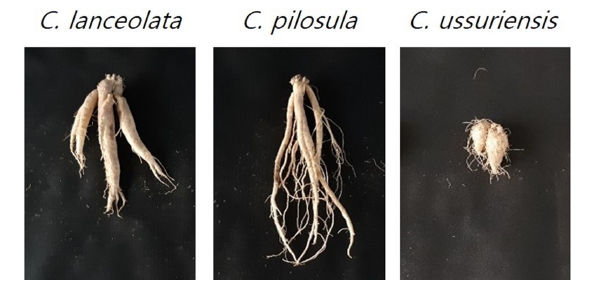
Morphological difference in root among 3 Codonopsis species.The shape of the roots was observed in 1-year-old roots.
근장의 경우 만삼은 26.3 ± 1.57 ㎝, 더덕은 19.3 ± 1.60 ㎝, 소경불알은 8.5 ± 0.64 ㎝의 순으로 나타났으며, 근경의 경우 더덕은 29.2 ± 4.60 ㎝, 소경불알은 24.2 ± 2.17 ㎝, 만삼은 13.9 ± 0.78 ㎝의 순으로 나타났다 (Table 3). 근중은 더덕이 85.7 ± 14.31 g으로 가장 높았으며, 만삼과 소경불알은 각각 32.1 ± 5.77 g, 25.0 ± 4.57 g으로 통계적으로 유의미한 차이는 없었다. 특히 더덕의 무게는 만삼과 소경불알에 비해 약 3 배 정도 높게 나타났다.
기존 더덕 속 연구에서도 3 가지 형태의 근형으로 나타난 것으로 보고 된 바 있는데 (Yoo and Lee, 1989), 본 연구결과도 기존 연구와 일치하였으며, 이는 더덕 속 식물의 종별 고유 형질에 기인한 것으로 생각된다.
4. 더덕 속 3 종의 종자 특성
더덕 속 3 종의 종자를 보면 더덕의 종자에는 날개가 달려있고, 만삼과 소경불알에는 없는 것으로 나타나 확연한 차이가 있음을 알 수 있었다 (Fig. 5).
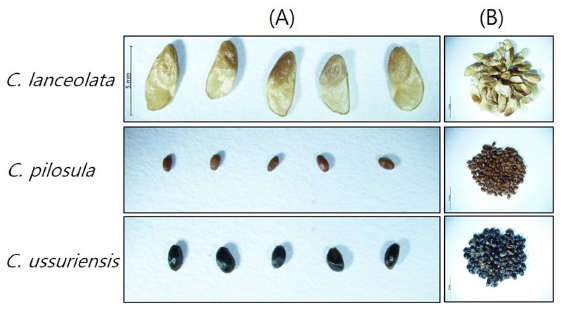
Morphological difference in seed among 3 Codonopsis species.(A) and (B) shows magnified individual seeds and general clustered seeds, respectively.
종자의 길이는 더덕이 2.69 ± 0.29 ㎜, 소경불알은 1.94 ± 0.15 ㎜, 만삼은 1.29 ± 0.09 ㎜의 순으로 나타났으며, 너비는 더덕이 1.52 ± 0.14 ㎜, 소경불알은 1.14 ± 0.07 ㎜, 만삼은 0.69 ± 0.05 ㎜의 순으로 나타났다 (Table 4).
또한, 천립중도 종자의 크기와 동일하게 더덕이 2.970 ± 0.013 g, 소경불알은 1.200 ± 0.001 g, 만삼은 0.330 ± 0.003 g의 순으로 나타났다.
기존 더덕 속 연구에서도 더덕의 종자만 날개가 있는 것으로 보고되었는데 (Yoo and Lee, 1989), 본 연구 결과도 기존의 연구 결과와 일치하였다.
5. 더덕 속 3 종의 주요 성분 함량 분석 비교
Tangshenoside I와 lobetyolin은 더덕 속 식물의 주요 화합물중 지표 성분으로 알려져 있다 (Ichikawa et al., 2009, Xia et al., 2017, Hwang et al., 2018). 본 실험에서 더덕 속 3 종의 주요 성분 함량은 1년생과 2년생의 뿌리에서 조사되었다.
더덕 속 3 종의 tangshenoside I와 lobetyolin 성분의 retention time은 각각 46.786 분과 64.178 분으로 나타났으며 (Fig. 6), 1년생 뿌리에서 tangshenoside I의 함량은 더덕 (1.36 ± 0.05 ㎍/㎎), 만삼 (1.01 ± 0.09 ㎍/㎎), 소경불알 (0.43 ± 0.07 ㎍/㎎) 순으로 존재하였고, lobetyolin의 함량은 만삼 (2.54 ± 0.03 ㎍/㎎), 소경불알 (1.30 ± 0.14 ㎍/㎎), 더덕 (0.81 ± 0.03 ㎍/㎎) 순으로 존재하였다. 1년생에서 tangshenoside I와 lobetyolin의 함량 합은 만삼 (3.55 ㎍/㎎), 더덕 (2.17 ㎍/㎎), 소경불알 (1.73 ㎍/㎎) 순으로 나타났다.
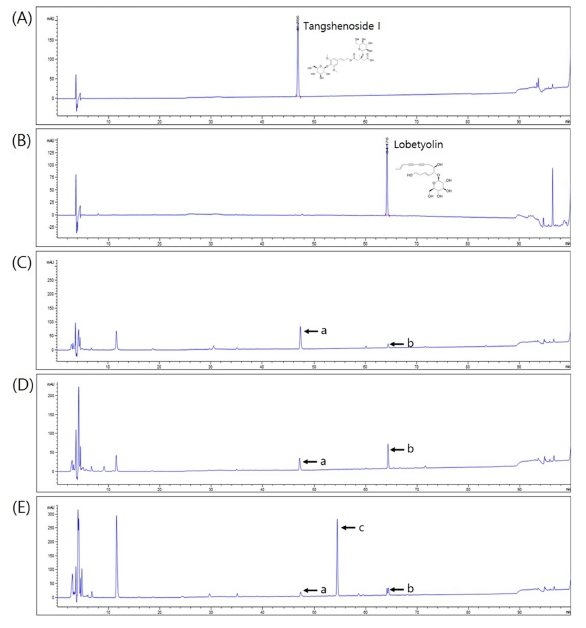
HPLC analysis of effective components from 3 Codonopsis species.(A) and (B) shows chromatogram of standard compounds, tangshenoside I (200 ㎍/㎖) and lobetyolin (200 ㎍/㎖), respectively. (C), (D) and (E) shows chromatogram of extract from C. lanceolate, C. pilosula and C. ussuriensis, respectively. Peak a: Tangshenoside I, peak b: Lobetyolin, peak c: Ussurienoside I.
2년생 뿌리에서 tangshenoside I의 함량은 더덕 (5.29 ± 0.15 ㎍/㎎), 만삼 (2.00 ± 0.14 ㎍/㎎), 소경불알 (1.36 ± 0.10 ㎍/㎎) 순으로 존재하였고, lobetyolin의 함량은 만삼 (4.42 ± 0.06 ㎍/㎎), 소경불알 (1.83 ± 0.02 ㎍/㎎), 더덕 (1.00 ± 0.03 ㎍/㎎), 순으로 존재하였다. 2년생에서 tangshenoside I와 lobetyolin의 함량 합은 더덕 (6.29 ㎍/㎎)과 만삼 (6.42 ㎍/㎎)에서는 유사하게 나타났고, 소경불알 (3.13 ㎍/㎎)에서는 상대적으로 낮게 나타났다.
HPLC 분석 결과 더덕 속 3 종 모두 1년생에 비해 2년생 뿌리의 tangshenoside I과 lobetyolin 함량은 증가하는 경향을 보였으며, 증가 비율은 tangshenoside I이 lobetyolin보다 높게 나타났다. 더덕에서는 tangshenoside I이, 만삼에서 lobetyolin이 각각 높은 함량을 나타내는 주요 성분임을 확인할 수 있었다. 그러나 소경불알에서는 tangshenoside I과 lobetyolin 사이에서 영역 값이 가장 높은 주요 peak (RT = 54.328)가 검출되었다. 최근 보고에 의하면 이 peak는 ultra-performance liquid chromatography–quadrupole–time-of-flight mass spectrometry (UPLC-Q-TOF/MS) 분석을 통해 ussurienoside I으로 확인되었으며, 이 단일 화합물은 항균효과를 나타내는 것으로 보고되었다 (Koo et al., 2022).
Ussurienoside I의 경우 오직 소경불알에서만 확인되었으며, 해당 peak의 영역 값 비교를 통해 1년생에 비해 2년생에서 크게 증가하였음을 확인할 수 었다. 그리고 소경불알에서 ussurienoside I은 다른 두 성분인 tangshenoside I과 lobetyolin보다 높은 영역 값을 보였다. 따라서 소경불알에서만 확인되는 ussurienoside I을 소경불알의 지표 성분으로 활용 가능할 것으로 생각한다.
본 연구 결과를 종합해 볼 때, 소경불알은 더덕과 만삼의 형질을 혼재하여 갖고 있는 것으로 나타났다. 생육 초기 줄기와 잎에 털이 존재하는 특징과 줄기의 색, 종자에 날개가 없는 특징, 뿌리 무게는 만삼과 비슷했으나, 잎의 모양과 크기, 화관의 외부와 내부의 색은 만삼과 더덕의 중간형질을 보였다. 그러나 뿌리의 형태는 3 종 모두 다르게 나타났다. 주요 성분은 3 종 모두 1년생보다 2년생에서 증가하는 증상을 보였다. 더덕과 만삼에서 각각tangshenoside I와 lobetyolin이 가장 높게 나타났으나, 소경불알에서는 다른 2가지 성분보다 ussurienoside I이 가장 높은 영역 값을 나타내었다.
본 연구 결과는 동일 조건에서 재배했기 때문에 소경불알의 작물화 연구의 기초자료로 가치가 있을 것으로 생각되나, 실제 농가에 정보를 전달하기 위해서는 추후 수량을 늘릴 수 있는 적정 재식 거리 및 비료 시비량에 대한 연구, 연생별 생산량 변화와 수익을 고려한 적정 재배 기간에 대한 연구 등 기본적인 재배연구들이 수행되어야 될 것으로 생각된다.
Acknowledgments
본 연구는 농촌진흥청 참당귀/더덕 품종 개발을 위한 분자 육종 체계 구축 (PJ01588302)에 의해 이루어진 결과로 이에 감사드립니다.
References
- Ahn DK. (2003). Illustrated book of korean medicinal herbs. Kyohak Co. Seoul, Korea. p.993.
- Hwang BS, Kim JY, Jang M, Kim GC, Park YH and Hwang IG. (2018). Quantitative analysis of tangshenoside I and lobetyolin from Korean Deoduk(Codonopsis lanceolata). Korean Journal of Food and Nutrition. 31:957-963.
-
Ichikawa M, Ohta S, Komoto N, Ushijima M, Kodera Y, Hayama M, Shirota O, Sekita S and Kuroyanagi M. (2009). Simultaneous determination of seven saponins in the roots of Codonopsis lanceolata by liquid chromatography-mass spectrometry. Journal of Natural Medicines. 63:52-57.
[https://doi.org/10.1007/s11418-008-0294-4]

- Kang JH, Shim YD and Jeon BS. (2001). Presown seed treatments to elevate seedling emergence of Codonopsis pilousla Nannf. Korean Journal of Medicinal Crop Science. 9:99-107.
- Kim GT. (2003). A study on the growth, photosynthetic rate and chlorophyll content of Codonopsis lanceolata by the growing sites. Journal of Korean Forestry Society. 92:27-32.
-
Kim HJ, Jeong HS and Kang SH. (2015). Ethnobotany of Jeju island, Korea. Korean Journal of Plant Resources. 28:217-234.
[https://doi.org/10.7732/kjpr.2015.28.2.217]

-
Kim JH, Jeong YH, Lee MS, Kim MK, Jo NS, Gil JS, Koo SC and Lee Y. (2023). Development of InDel markers to distinguish among Codonopsis Species. Korean Journal of Medicinal Crop Science. 31:12-17.
[https://doi.org/10.7783/KJMCS.2023.31.1.12]

- Kim JH, Kim JS, Nam GH, Jung EH, Lee KU and Hwang YS. (2018). Vascular plant diversity and vegetation of Sanmusan Mt. in Jecheon-si, Korean Peninsula. Korean Journal of Plant Resources. 31:396-418.
-
Kim KA and Yoo KO. (2011). Phylogenetic relationships of Korean Campanulaceae based on PCR-RFLP and ITS sequences. Korean Journal of Plant Taxonomy. 41:119-129.
[https://doi.org/10.11110/kjpt.2011.41.2.119]

- Kim SY and Kim CS. (2010). Analysis of FISH patterns using 5S and 45S rDNAs in Codonopsis minima and C. lanceolata from Jeju island. Korean Journal of Medicinal Crop Science. 18:186-190.
-
Koo SC, Woo HS, Kim JW, Kim YS, Kim JY, Kim JH, Yu J, Kim YC and Kim DW. (2022). Discovery and characterization of chemical compounds that inhibit the function of bacterial neuraminidase from Codonopsis ussuriensis. Applied Sciences. 12:6254. https://www.mdpi.com/2076-3417/12/12/6254, (cited by 2023 May 30).
[https://doi.org/10.3390/app12126254]

- Lee IR and Kim WR. (1989). A study on physiological activity of Codonopsis ussuriensis. Korean Journal of Pharmacognosy. 20:233-242.
-
Lee IR and Ko JH. (1992). Isolation of triterpenoid and phenylpropanoid from Codonopsis ussuriensis. Archives of Pharmacal Research. 15:289-291.
[https://doi.org/10.1007/BF02974100]

-
Lee SG, Ku JJ, Cho WW and Kang HD. (2013). Effects of rice hull cover for seed germination, types of tray and soil, shading conditions for seedling growth of Codonopsis pilosuala. Journal of Korean Society of Forest Science. 102:66-73.
[https://doi.org/10.14578/jkfs.2013.102.1.066]

-
Lee SH, Choi HJ, Heo JC, Lee JH, Kwon TK, Ha SC and Lee SH. (2017). Comparison of anti-asthmatic activity by native Codonopsis lanceolata extract. Journal of Life Science. 27:450-455.
[https://doi.org/10.5352/JLS.2017.27.4.450]

- Lee WT, Paik WK and Yoo KO. (1997). Distribution survey on medicinal palnts in Kangwon province. Korean Journal of Plant Resources. 10:275-291.
- Ministry of Agriculture, Food and Rural Affairs(MAFRA). (2022). 2021 an actual output of crop for a special purpose. Ministry of Agriculture, Food and Rural Affairs. Sejong, Korea. p.6-7.
- Na N, Kim YY, Lee G, Song HI, Park JM and Jang CG. (2017). Floristic study of Mt. Deoktaesan, Jinan, Jeonbuk. Korean Journal of Plant Resources. 30:378-398.
- Park JH, Kueon SJ and Oh JY. (2005). Parmacognostical studies on the Chinese crude drug “Man Sam”. Korean Journal of Pharmacognosy. 36:21-25.
- Rural Development Administration(RDA). (2012). Agricultural science and technology research analysis standards. Rural Development Administration. Suwon, Korea. p.803-805.
-
Son HJ, Kim YS, Kim NY, Lee HB, Kim SC, Lee HB and Park WG. (2015). Plants species diversity and flora of wetlands in the forest of Gangwon province. Korean Journal of Plant Resources. 28:419-440.
[https://doi.org/10.7732/kjpr.2015.28.4.419]

- Sun EM, Son DC, Kim HW, Ha YH, Gil HY, Lee KH and Oh SH. (2020). The vascular plants of Mt. Taegi(Gangwon-do), Korea. Korean Journal of Plant Resources. 33:337-364.
- Sung JW, Yoon JW, Shin HT, Bae JK, Kang SG and Yi MH. (2019). The vascular plants in Mt. Guryong, Korea. Korean Journal of Plant Resources. 32:589-614.
-
Xia Y, Liu F, Feng F and Liu W. (2017). Characterization, quantitation and similarity evaluation of Codonopsis lanceolata from different regions in China by HPLC-Q-TQF-MS and chemometrics. Journal of Food Composition and Analysis. 62:134-142.
[https://doi.org/10.1016/j.jfca.2017.05.009]

-
Yoo KO and Lee WT. (1989). A taxonomic study of the genus Codonopsis in Korea. Korean Journal of Plant Taxonomy. 19:81-102.
[https://doi.org/10.11110/kjpt.1989.19.2.081]

-
Yoo KO and Lee WT. (1996). External morphology of Korean Campanulaceae. Korean Journal of Plant Taxonomy. 26:77-104.
[https://doi.org/10.11110/kjpt.1996.26.2.077]

-
Yoon KK, Moon KG, Kim SU, Um IS, Cho YS, Kim YG and Rho IR. (2016). Analysis of growth and antioxidant compounds in Deodeok in response to mulching materials. Korean Journal of Medicinal Crop Science. 24:183-190.
[https://doi.org/10.7783/KJMCS.2016.24.3.183]

